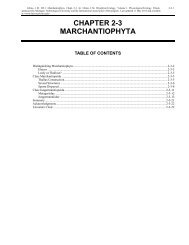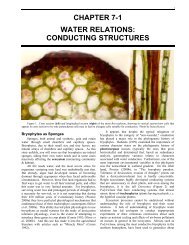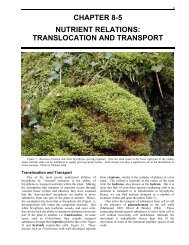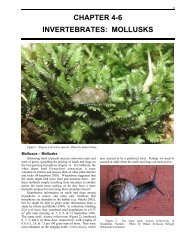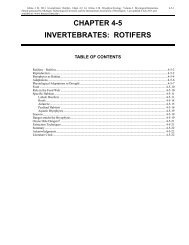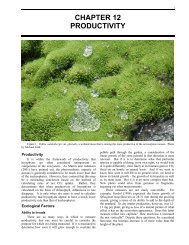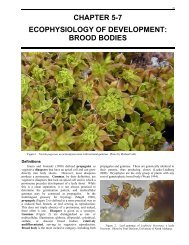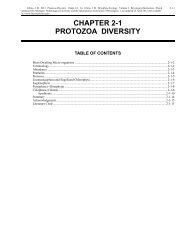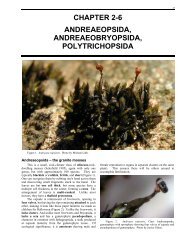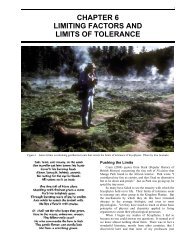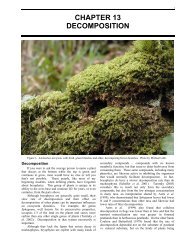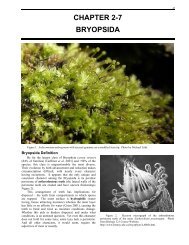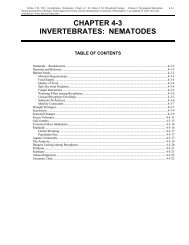Chapter 5: Construction - Bryophyte Ecology
Chapter 5: Construction - Bryophyte Ecology
Chapter 5: Construction - Bryophyte Ecology
Create successful ePaper yourself
Turn your PDF publications into a flip-book with our unique Google optimized e-Paper software.
Tortula/Syntrichia, and Racomitrium will colonize the<br />
more exposed areas, whereas pleurocarpous taxa such as<br />
Mniaceae and Brachythecium will colonize shadier sites.<br />
Henk Greven suggested that Polytrichum formosum is<br />
easily transplanted and he would expect it to do well on<br />
roofs. Michel Chiaffredo has shown this to be the case<br />
(Figure 14; Figure 15).<br />
Controversies have arisen regarding the best upkeep<br />
for the green roof. Ideally, these roofs are low or no<br />
maintenance ecosystems. Thus, we would anticipate no<br />
need for fertilizers, which generally seem detrimental to<br />
bryophytes anyway. However, many of the roof gardens<br />
that have been in existence seem to be deteriorating<br />
(Koehler 2003), leading the roof gardeners to promoting<br />
fertilization. Chiaffredo and Denayer (2004) disagree with<br />
this approach, concluding that it is "contrary to the very<br />
definition of extensive vegetalization." The International<br />
Green Roof Association lists the moss-sedum-herbs and<br />
grasses community as a low maintenance, low cost green<br />
roof plant community (IGRA).<br />
Figure 14. These large mats of Polytrichum are ready for<br />
transplantation to a "green roof" site. Photo by Jan-Peter Frahm.<br />
The principle of the green roof for some companies<br />
relies on the well-known ability of mosses to colonize such<br />
a substrate with no help from us (Figure 16). At this stage,<br />
they are pioneers and require no watering or fertilizer<br />
(Figure 17). Diversity develops normally, hence providing<br />
stability (Figure 18). Their development can be compared<br />
to that of the cryptogamic crust that is so important in<br />
anchoring and nurturing the soil of prairies and semideserts<br />
in the North American Southwest, Israel, and parts of<br />
China and Australia. These crusts remove CO2 from the<br />
atmosphere, convert atmospheric N to ammonia and<br />
nitrates, and generally improve the quality of the habitat for<br />
invading organisms, while improving the air quality for<br />
humans.<br />
Using the studies on bryophytes as pioneers in these<br />
natural habitats as models, green roof landscapers have<br />
conducted studies on the best substrates for the roofs. The<br />
<strong>Chapter</strong> 5: <strong>Construction</strong><br />
most popular and successful roofing material is a mineral<br />
one of volcanic origin, having a granulometric variation of<br />
1-16 mm. Fentiman Consulting advocates a thin layer of<br />
concrete as a substrate for moss establishment (Grant<br />
2006).<br />
Figure 15. Polytrichum displays a marvelous collection of<br />
capsules with hairy caps in the background and numerous male<br />
splash cups in the foreground. Photo by Jan-Peter Frahm.<br />
Figure 16. Buildings in Norway with natural green roofs.<br />
Photo by Michael Lüth.<br />
Figure 17. Seashore damaged by tourists shows damaged<br />
bare sand area and restored area beyond the rope. Photo by<br />
Michel Chiaffredo.<br />
In London, England, the CUE Building of the<br />
Morniman Museum did not begin with bryophytes on its<br />
green roof (Grant 2006). However, successful<br />
5



